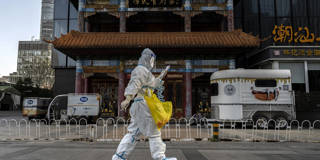Although it has been almost a year since China rescinded its strict zero-COVID policy and allowed normal economic activity to resume, the costs of the country’s pandemic experience are still being tallied. As job and pay cuts continue alongside slowing economic growth, younger generations are confronting a disconcerting new reality.
SHANGHAI – For three years, China’s zero-COVID policy consistently received high-profile media coverage from the Chinese and the international press. During the first phase of the pandemic, China’s mass mobilization of resources and strict region-wide lockdowns were seen as highly effective – a testament to the advantages of autocratic power. But after vaccines arrived and Western countries resumed normal economic activities, China’s ongoing restrictions became a source of growing concern.
Then, when the restrictions were finally lifted in late 2022, the press coverage dissipated, and the official Chinese position was silence. Just as the Chinese people were starting to regain their economic footing and reckon with the emotional fallout of the previous three years, the world stopped paying attention.
Yet the legacy of zero-COVID will not soon be forgotten. For three years, nearly every city was under various forms of lockdown, with as many as 370 million people isolated in their homes at the policy’s peak. Shanghai, China’s economic hub, was among the cities subjected to the most severe lockdowns. When it was shuttered for two months in 2022, economists worried that national GDP would fall by several percentage points.

SHANGHAI – For three years, China’s zero-COVID policy consistently received high-profile media coverage from the Chinese and the international press. During the first phase of the pandemic, China’s mass mobilization of resources and strict region-wide lockdowns were seen as highly effective – a testament to the advantages of autocratic power. But after vaccines arrived and Western countries resumed normal economic activities, China’s ongoing restrictions became a source of growing concern.
Then, when the restrictions were finally lifted in late 2022, the press coverage dissipated, and the official Chinese position was silence. Just as the Chinese people were starting to regain their economic footing and reckon with the emotional fallout of the previous three years, the world stopped paying attention.
Yet the legacy of zero-COVID will not soon be forgotten. For three years, nearly every city was under various forms of lockdown, with as many as 370 million people isolated in their homes at the policy’s peak. Shanghai, China’s economic hub, was among the cities subjected to the most severe lockdowns. When it was shuttered for two months in 2022, economists worried that national GDP would fall by several percentage points.